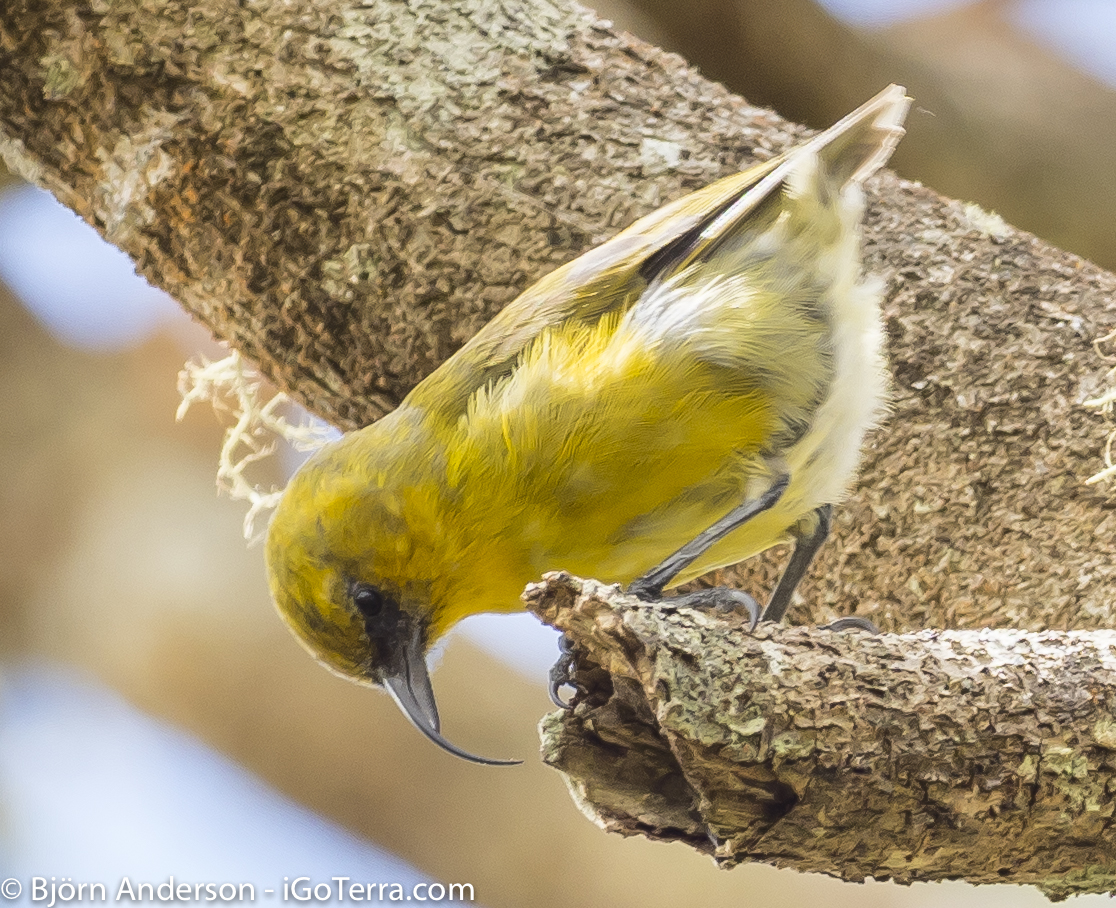Several Hawaiian honeycreepers are facing imminent extinction due to avian malaria carried by invasive Southern House Mosquitoes. Members of the multi-agency partnership Birds, Not Mosquitoes (BNM) have begun releasing non-biting male Southern House Mosquitoes on Maui and Kaua‘i that reduce invasive mosquito reproduction and cause their populations to decrease. Following years of rigorous study and analysis, the releases began in November 2023 after regulatory approval from state and federal agencies.
“This really is a critical milestone as it demonstrates the strength of our partnerships to ensure the long-term survival of our island’s honeycreepers,” said Dr. Earl Campbell, U.S. Fish and Wildlife Service Field Supervisor for the Pacific Islands Fish and Wildlife Office. “It is made even more momentous as our collaborative efforts occur during Makahiki o Nā Manu Nahele, the Year of the Forest Bird.”
This work is part of the U.S. Department of Interior’s Strategy to Prevent the Extinction of Hawaiian Forest Birds and it is urgent: Hawaiʻi’s forest birds have declined from more than 50 different native honeycreepers to just 17 species remaining today.

Akiapolaau, copyright Bjorn Anderson, from the surfbirds galleries
“Manu (birds) are revered as our ‘ohana (family) and for too long, their songs have been declining,” said Ulalia Woodside Lee, Executive Director, The Nature Conservancy Hawai‘i and Palmyra. “We have a kuleana, a responsibility, to give nā manu nahele (forest birds) a chance to nourish Hawaiian culture and spirit, as well as pollinate our forests and keep them growing. We are looking forward to the day when honeycreepers aren’t rare in Hawaiʻi’s forests.”
Mosquitoes are rapidly moving to higher elevations as the climate changes and native forests get warmer and drier. Without significantly reducing mosquito populations, multiple native bird species are likely to go extinct in the wild in less than 10 years, including the Kiwikiu and ʻĀkohekohe on Maui, and ʻAkikiki and ʻAkekeʻe on Kauaʻi.
“After decades without the tools to solve this problem, this project is our best chance to save the birds and native forests for future generations,” said Dr. Chris Farmer, Hawai‘i Program Director for American Bird Conservancy (ABC). “I am excited and honored to be part of this historic collaboration to address difficult, previously intractable conservation problems, and commit to long-term solutions.”
The male Southern House Mosquitoes, which do not bite or transmit disease, carry a strain of the common, naturally occurring Wolbachia bacteria. When they mate with females in the wild, which carry a different strain of this bacteria, their eggs don’t hatch, causing the mosquito population to decrease. No new species are being introduced to Hawai‘i; both the mosquitoes and the Wolbachia bacteria are already here. This method has been safely used to control the spread of human diseases by mosquitoes around the world.
“This project is our best opportunity to reverse the trend of shrinking bird populations for these species that are found only in Hawaiʻi,” said Dr. Lindsey Nietmann, Forest Bird Recovery Coordinator for the Hawai‘i Department of Land and Natural Resources Division of Forestry and Wildlife. “In addition to protecting the birds that remain in our forests, we hope these efforts will one day lead to the release of captive populations that are currently in conservation breeding facilities and awaiting re-introduction to the wild.”
Monitoring is an essential part of this project. It helps determine if mosquito populations are decreasing, malaria prevalence is decreasing, and native bird populations are stabilizing or increasing. Maui Forest Bird Recovery Project (MFBRP) has been leading implementation on Maui. Landscape-level deployment has begun over a few thousand acres of remote forests on East Maui.
“Our monitoring is driven by science and is designed to gather the best possible data,” said Dr. Christa Seidl, MFBRP’s Mosquito Research and Control Coordinator. “Our field team provides essential boots on the ground and in the air, spending long, often wet days in remote forests checking mosquito traps and collecting data.”
Kaua‘i Forest Bird Recovery Project has been leading efforts on Kaua‘i, and has completed small-scale pilot releases to assess how far the male mosquitoes travel. Next steps include releases over a few thousand acres of forest on the Alaka‘i Plateau.
This project could not have happened without substantial state and federal partnership and funding. In particular, the current administration’s Investing in America Agenda committed nearly $16 million through the Department of the Interior to catalyze extinction prevention in Hawai‘i. This funding is part of the broader Hawaiian Forest Bird Conservation Keystone initiative. The National Fish and Wildlife Foundation is also a major supporter.
“This effort represents the culmination of decades of collaborative research between the Department of the Interior and State biologists, non-governmental organizations, and private enterprises,” said Dr. Dennis LaPointe, Research Ecologist at United States Geological Survey Pacific Island Ecosystems Research Center. “The timely development of this safe and effective tool to suppress mosquito populations in forest bird habitats brings new hope for the preservation of the remaining Hawaiian honeycreepers.”
In 2024, the partnership will continue releases on Maui, expand releases on Kaua‘i, and prepare a Statewide Environmental Assessment. The State Department of Health will lead that assessment, which will address application of this method for both conservation and public health.